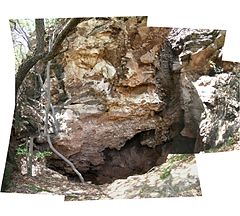Gondolin Cave

Composite view
|
|
| Location | Northwest Province |
|---|---|
| Region | South Africa |
| Coordinates | 25°49′37″S 27°50′49″E / 25.82694°S 27.84694°ECoordinates: 25°49′37″S 27°50′49″E / 25.82694°S 27.84694°E |
Gondolin Cave is a fossiliferous dolomitic paleocave system in the Northwest Province, South Africa. The paleocave formed in the Eccles Formation dolomites (Malmani Subgroup, Chuniespoort Group carbonate-banded iron formation marine platform). Gondolin is currently the only described hominin-bearing fossil site in the Northwest Province-portion of the designated Cradle of Humankind UNESCO World Heritage Site. The cave is located on privately owned land and is not accessible to the public. As is the case with other South African Paleo-cave systems with Pliocene and/or fossil deposits, the system was mined for lime during the early 20th century. As a result, the system has been heavily disturbed and consists of only a small active cave, a series of in situ remnant cave deposits, and extensive dumpsites of ex situ calcified sediments produced during mining activities.
No records of the date of lime mining activities at Gondolin, maps or photographs of the cave prior to minining are known to exist. Long-term residents near Gondolin report that the system was mined prior to the 1950s. The cave was named after J.R.R. Tolkien's Gondolin by the early 1970s. Exposed fossils in the cave system were noted at least as early as the 1970s and brought to the attention of Elisabeth Vrba and David Panagos at the (then) Transvaal Museum (now the Ditsong National Museum of Natural History), who initiated excavations in early 1979. The first phase of excavation addressed the extremely fossiliferous in situ remnant deposits adhering to the northern wall of the cave system (the GD 2 deposits sensu). The three-week 1979 excavation removed approximately 2 m3 (71 cu ft) of calcified sediments from the northern cave wall. While two distinct sediment phases were recognized during the original excavation, later work with the fossil fauna and geology of the GD 2 deposits did not find any basis for multiple depositional phases within the sampled sequence. The removed sediment blocks were organised into 43 blocks/trays and processed using acetic acid at the Transvaal Museum. A significant gap in research at Gondolin occurred in the 1980s, during which time all of the excavated blocks were processed (but no further in situ or ex situ sampling is known to have occurred). The first description of the result fossil assemblage in 1993 only partially described 4,344 individual specimens that could be assigned to a specific taxonomic levels (out of the 90,663 total specimens recovered from acetic acid processing of the 43 trays/blocks).
...
Wikipedia

